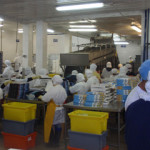Although UK consumers are growing increasingly adventurous with the fish that they eat, they are still passing up on much of the shellfish that the country produces. As a result, a lot of the crabs, lobsters and langoustines landed in Britain end up in welcoming European markets, alongside British oysters, mussels and scallops.
France and Spain are the United Kingdom’s biggest shellfish customers, and consumers there will pay top dollar for the aforementioned products. However, there’s a growing feeling by both UK industry and government that a great opportunity is being missed.
Speaking at the Shellfish Association of Great Britain’s (SAGB) 43rd Annual Conference, held in London on 22 and 23 May, UK Fisheries Minister Richard Benyon said part of his 10-year vision for the country’s shellfish and marine aquaculture industries is to see much more product being sold in the domestic market.
“Instead of the value-added profit going to restaurateurs in other countries, I wish we could see a boost to our own, local economy,” said Benyon. “I can’t understand why local restaurants aren’t fighting over landings of shellfish.”
He told delegates: “I want to work with you to find new ways in which we can unlock the fruits of our sea to more of our indigenous people and less to line the pockets of value-added markets elsewhere.
“There’s every reason why sustainably fished shellfish can make a contribution to the great agenda. Just a few miles over the Channel, eating shellfish is an event; it’s about families sitting down together and taking part in a communal activity. I would like to import that part of European culture here — to see more of that happening around our families’ tables and in our restaurants. Our chefs, cookery writers and restaurants all love local, fresh products, so let’s make the most of that.”
The minister highlighted that UK vessels landed GBP 266 million (EUR 333.2 million, USD 414.4 million) of shellfish in 2010, while farmed shellfish contributed an additional GBP 26 million (EUR 32.6 million, USD 40.5 million). He said while the two industries “tick all the right boxes” in terms of government policy, from boosting exports to improving the nation’s health, more innovation is required to ensure their full potential is met.
“There’s a great future ahead, which doesn’t rely solely on government think tanks and regulations. I want the innovators to show the way,” said Benyon. “The FSA (Food Standards Agency) recommends that we all eat two portions of fish or shellfish per week; we also know that the population of the UK will be 71 million by 2035. That means that about 20 million more portions of fish and shellfish will be required every week in this country by then if we are to meet the FSA’s recommendation. That’s a huge challenge for this industry and the government.”
So why are UK consumers being more daring with their finfish consumption but not with shellfish?
Shellfish come in a raft of shapes and sizes, whereas finfish, whether whole or filleted, is nevertheless familiar in format. But perhaps a divide has been created because almost all of the recent promotions of so-called “alternative species” like “Fish Fight” and “Switch the Fish” have focused on finfish. By comparison, most shellfish species have been kept out of the limelight.
Hoping to help address this imbalance, a new initiative called “Crabstock” has been launched with the aim of ramping up consumer support for the shellfish industry. It has had the backing of both the SAGB and Seafish.
Crabstock was dreamed up by chef Matthew Ayres and Adrian Bartlett of The Really Interesting Crab Co. to inform consumers about the benefits of eating shellfish and to get local communities involved with the UK fishing industry through a live music and food festival.
Held over two days in April in the grounds of Ayres’ restaurant, The Lamb Inn, in the Cotswolds, which is possibly one of the most landlocked areas of the country, Crabstock was visited by 2,000 people and was thought to be the country’s first inland fish festival. It promoted brown crab, spider crab, fiddler crab, lobsters, cockles, clams, mussels, oysters and scallops.
“The general public isn’t aware of shellfish; there’s a real lack of knowledge,” Ayres told the SAGB conference. “And also in my professional experience, I have found that a lot of chefs are numb to shellfish; they don’t know what to do with it. Yet Crabstock has shown us that people really do care about local produce.”
Ayres and Bartlett are now looking into ways of rolling out the Crabstock concept to the rest of the country. They are also planning a “Cotswold Shellfish Week,” involving all the chefs in the area and getting their restaurants to promote UK shellfish, probably with the help of a new “Great British Shellfish” logo.
“From a chef’s point of view, it’s exactly what you need. It proves you are using UK shellfish, you’re supporting U.K. fishermen and you have the provenance of where your food has come from. I believe the catering industry is crying out for this,” said Ayres.
Factoring in the growth of the UK population, referred to by Benyon, increasing sales in inland areas could prove to be a key driver for the shellfish industry’s long-term success. While this might create a few logistical headaches initially, they should be outweighed by the rewards.
What’s more, Ayres said his own restaurant’s sales of shellfish have grown ten-fold since Crabstock.






